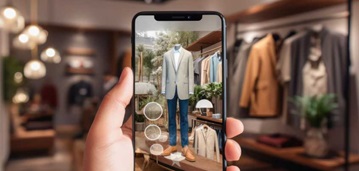The IT Innovator’s Guide to Digital Transformation in Retail

Introduction
The retail industry is undergoing a transformation, due in large part to the influence of technology. Shoppers today are reaching for their computers, smartphones and other mobile devices to discover, research and make purchases, expanding and redefining the traditional shopping experience both inside and away from brick and mortar stores.
Online shopping is occurring, and growing at a fast clip. While mobile devices are being used mostly for research and price comparisons, almost half of all shoppers report having used their devices to make purchases.
Consumers’ growing reliance on technology as a shopping tool affords opportunities for retailers to deliver a customer-centric sales environment. Retailers must embrace technology not only to provide tools and services that enhance the shopping experience, but also to help them improve their operations and enable new, innovative ways to keep their customers happy.
The right network is key to enabling a technology-focused, customer-centric environment, as retailers understand the impact their network has on the speed, agility and flexibility of the systems that serve their customers, which ultimately impacts their bottom line.
Market Forces
Ecommerce has certainly impacted the way consumers approach shopping, with browsing done as much online as through the aisles in a store. Beyond establishing a web page, however, retailers have done little to take advantage of technology as a vehicle for engaging customers and increasing sales.
A younger, technology-centric generation of consumers may force a change, however. Millennials—those born in the early 1980s through the late 1990s or early 2000s—grew up in a society in which email, mobile phones and iPods are ubiquitous, now even outdated. Their formative years were spent in front of screens of varying sizes. They are technology-savvy and have no qualms about grabbing their smartphone to make a purchase online.
Millennials’ comfort level with conducting transactions via the web is just one reason why ecommerce spending has cut into brick-and-mortar spending. More than half of consumers now make half of their purchases on the web, and an almost equal amount are turning to their smartphones to make a purchase. And although Millennials make the majority of their purchases online, other generations are catching up quickly.
The shopping experience is further being impacted by online retailers and marketplaces, which are siphoning sales from brick and mortar stores. The ability to shop for multiple types of items, potentially at lower than in-store prices, is appealing to consumers, who increasingly are turning to marketplaces in particular to do their shopping.
For a retailer to survive and even thrive in this environment, it must adopt an omnichannel approach to sales — which means having a strong presence in both online and the physical world.
Consumers expect to use their mobile devices in the retail store as part of an omnichannel shopping experience, to read customer reviews of a product or check competitors’ prices, for example. And they expect the retailer to offer a WiFi network to support those actions.
Finding ways to integrate the valued features of an online shopping experience — information about a product, inventory, price comparisons and customer reviews, all at the consumer’s fingertips — into a retail environment is increasingly the secret to success for many retailers. It’s what customers want — and, in many cases, what they expect.
Big Data Driving the New Retail Experience
Behind the scenes, big data and other technologies are helping create an impactful experience for shoppers while enabling inventory and other back-office efficiencies. For one, big data can help retailers discern customer sentiment by collecting and analyzing both structured and unstructured data from their website and external sources such as social media sites.
Big data also can be used to provide personalized customer shopping experiences. Using information collected from previous transactions, social media sites and even a customer’s location from GPS, retailers could send out highly targeted advertising, including coupons and other promotions, directly to customers’ smartphones when they are near or in the store.
In the back office, big data can be used to enable a retailer to target consumers who are likely customers for a new or upcoming product or service. Using data transaction records, data from loyalty programs and other information, retailers can pinpoint which of their customers are most likely to purchase their latest offering—and even how many.
Such forecasting information is useful for inventory control and ensuring retailers will be able to meet customer demand. It also helps improve customer service, by providing customer service centers with useful information about certain customers—especially the most loyal ones—to deliver even higher levels of service.
Indeed, the impact big data can have on the retail space is profound, helping retailers to better manage their costs and improve their bottom line.
Getting Personal Requires Strong Connections
Providing a top-notch shopping experience isn’t solely reliant on big data, however. Myriad other technologies can work to help retailers enhance customer interactions, creating personal experiences that can improve both trust in and loyalty to the retailer.
Beacons, for one, can help personalize customer experiences, tracking customers and providing purchase suggestions when a customer enters a retail location. Beacon technology takes geolocation marketing a step further by “waking up” an app a customer has downloaded but doesn’t have open on his or her device, reminding the customer of shopping list items or other related information.
Other services such as “magic mirrors” that show apparel in different colors or a digital concierge could reduce “dressing room abandonment” by enabling customers to request another size by utilizing a touchscreen embedded in the mirror instead of waiting for an attendant to check on their progress.
Such technology not only could help keep customers in the store, but also increase the amount customers spend, as they have more time to browse the store.
Point-of-sale systems, too, can enhance customer experience. Moving from behind the checkout counter and into retail associates’ hands, POS devices enable associates to conduct transactions anywhere in the store and reduce customers’ time spent waiting to make their purchases. Speed and convenience is increased for both the customer and the retail establishment, fostering customer goodwill and increasing the likelihood of a return visit.
Beyond the physical location, retailers also are looking to social networks to help increase awareness and even generate sales. Whether through ads consumers can click through to the retailer’s site or by using social as a customer service tool to answer questions and resolve issues, social media is growing in popularity as a must-have technology for retailers.
Retail and the Distributed Enterprise
For retailers with multiple stores across numerous states, ensuring a top-notch customer experience goes well beyond knowing a customer in one particular location. Rather, retailers must focus on providing a consistent experience across all locations, both brick and mortar and online.
Supply chain management can be a major factor in providing a consistent experience. Knowing inventory levels in real time can help retailers serve their customers in-store and online, increasing sales in-store through kiosk ordering of out-of-stock items in the store while reducing the amount of abandoned shopping carts on the retailer’s website.
In stores, streaming video featuring the latest fashions or cooking demonstrations using a brand’s cookware can help provide a consistent experience across multiple locations. The same videos, along with related content, also could run on the retailer’s website, including links to purchase the items featured in the videos. Such aggregated content helps to extend brand consistency across all platforms.
Dedicated, broadband and WiFi connections are necessary to enable high-quality back-office and customer-facing experiences.
Having the Right Network
To ensure always-on connectivity today and provide the path for advanced technologies down the road, retailers should look for a network service provider that can provide a secure, high-performance network that can be adjusted to meet dynamic bandwidth needs. A good network service provider will address current demands and anticipate future needs to guarantee the retailer can continue to provide its customers with a stellar experience both online and in-store.
Look for a network provider who can handle every aspect of the network, from provisioning to management and field technology services, for installation, maintenance and repairs. That way, retailers can focus on providing the best customer experience possible instead of tending to their networks.
Download the PDF here.
The retail industry is undergoing a transformation, due in large part to the influence of technology.
Locked Content
Click on the button below to get access
Unlock NowOr sign in to access all content on Comcast Business Community
Learn how Comcast Business can help
keep you ready for what's next.











